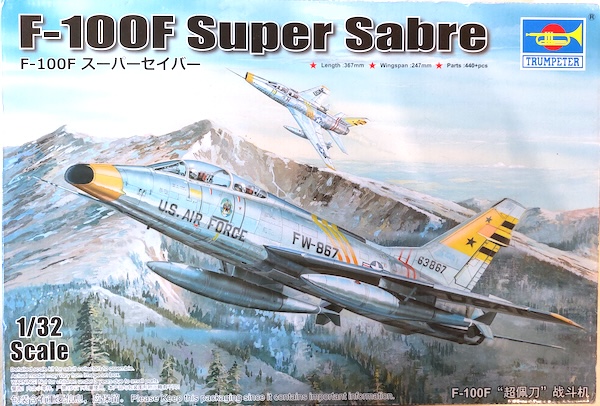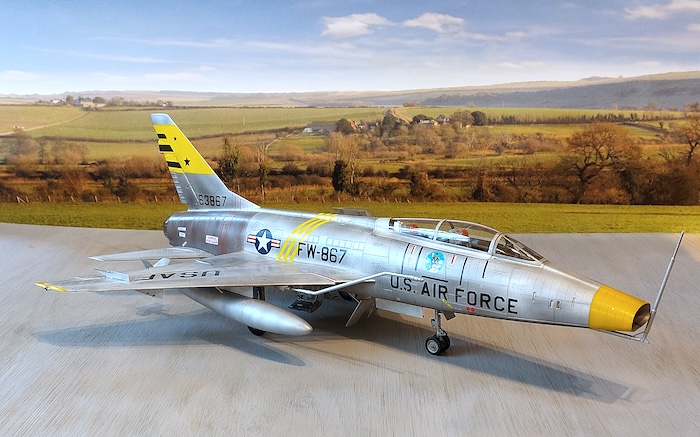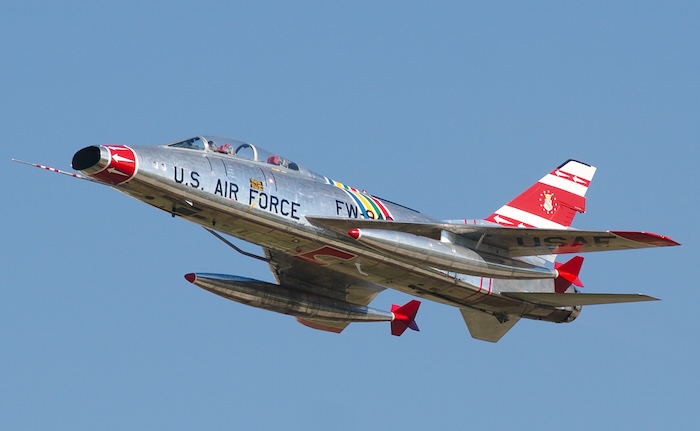
Full Review with Rob Ruscoe
Just before we get started, here’s a look at how it all turned out…

The Super Sabre was the first of the ‘hundred’ series of fighter aircraft produced in the 1950s and was also the first to exceed Mach 1 in level flight. The designation F-100 also caused its pilots to nickname it ‘The Hun’. Presented by North American as an evolution of the highly successful F-86 Sabre, the airframe actually shared very little with its younger sibling. Indeed, compared with the fine handling F-86, the Super Sabre initially demonstrated a number of undesirable aerodynamic qualities in initial testing. Three major deficiencies were identified as unacceptable. The worst of these was severe inertial roll/yaw coupling. This basically meant that any aileron input made by the pilot to roll the aircraft also caused an un-demanded yaw in the opposite direction. This yaw then caused a roll in the same direction of the yaw. If the pilot tried to ‘chase’ this Dutch Roll effect, he could very easily get out of phase with his control movements and the result at best would be to over stress the airframe.
A number of the early supersonic jets, including the British Lightning, suffered from inertial coupling and enlarging the fin and incorporating a yaw damper usually made things more than acceptable. In the F-100s case, an enlarged fin and the addition of a yaw damper and wing fences did bring about an improvement but only to a just acceptable level and the aircraft always had a reputation for adverse handling. Also in common with other swept-wing aircraft of the time, the wing exhibited a rapid rise in drag at high angles of attack. This drag could quickly increase to a level which exceeded the amount of thrust available from the engine – even with the use of afterburner. If sufficient height was not available to reduce the A of A, for example on final approach, the aircraft would enter what the pilot’s called ‘Coffin Corner’ which was not recoverable. The famous ‘Sabre Dance’ film of this occurring was one of the first things shown to a new F-100 pilot during his conversion to the aircraft. Must have been quite inspiring! These problems were mitigated by training new Hun pilots to avoid mis-handling the controls and the accident rate for the main production model, the F-100D reduced to a level similar to other high performance fighters. A two-seater version of the Super Sabre would also be of great advantage for pilot training and the F-100F duly appeared in 1957.

(Photo: F-100 Super Sabre over Airventure 2015. Courtesy Michaela Pereckas)
A number of these two-seaters were famously modified as Wild Weasel SEAD (Suppression of Enemy Air Defences) aircraft for use in the ongoing Vietnam War. Although suffering a high loss rate, these aircraft proved to be very effective until the F-105F Thunderchief took over the role.
The Kit
Trumpeter’s single seat F-100D first appeared in 2007 and has seen various re-boxings with different markings. The two-seater F variant didn’t see daylight until 2020 and of course contained a lot of new parts. Les Venus built a lovely model of the D for SMN a few years ago and his article is well worth a read if building the earlier kit. I wanted to build the F version because, to me, it looks sleeker than the single seater. I also wanted to build this kit straight OOB to see if the result was good enough to avoid any expensive aftermarket items.
This is the second Trumpeter kit in a row to grace my bench having just completed their Grumman Albatross. The packaging is up to the usual sturdy standard and is absolutely packed with goodies. There are no less than fifteen sprues of styrene along with two clear sprues, a large PE fret, rubber tyres, three decal sheets for two options and, of course, the usual Trumpy instruction booklet which proved to be logical and easy to follow. The (large) fuselage is made up of four main pieces which can be modelled with the tail section separate to expose the detailed J57 engine. The engine can also be modelled standing next to the aircraft on its servicing stand. Full intake ducting is also provided although not much of this will be visible on the completed model. One criticism of this kit by other reviewers is the shape of the nose intake. Comparing this to photographs did reveal that the lower lip is indeed a little flatter than the real thing. There is a resin replacement available in exchange for quite a few of our English pounds if you want to correct this but I decided to live with it.